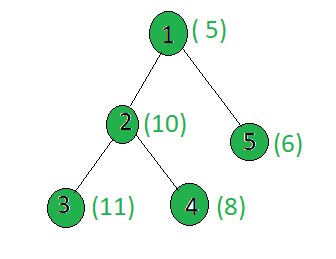给定一棵树,以及所有节点的权重,任务是计算权重为2的幂的节点数。
例子:
Input:
Output: 1
Only the weight of the node 4 is a power of 2.
方法:在树上执行dfs,对于每个节点,检查其权重是否为2的幂,如果是,则增加计数。
下面是上述方法的实现:
C++
// C++ implementation of the approach
#include
using namespace std;
int ans = 0;
vector graph[100];
vector weight(100);
// Function to perform dfs
void dfs(int node, int parent)
{
// If weight of the current node
// is a power of 2
int x = weight[node];
if (x && (!(x & (x - 1))))
ans += 1;
for (int to : graph[node]) {
if (to == parent)
continue;
dfs(to, node);
}
}
// Driver code
int main()
{
// Weights of the node
weight[1] = 5;
weight[2] = 10;
weight[3] = 11;
weight[4] = 8;
weight[5] = 6;
// Edges of the tree
graph[1].push_back(2);
graph[2].push_back(3);
graph[2].push_back(4);
graph[1].push_back(5);
dfs(1, 1);
cout << ans;
return 0;
} Java
// Java implementation of the approach
import java.util.*;
class GFG
{
static int ans = 0;
@SuppressWarnings("unchecked")
static Vector[] graph = new Vector[100];
static int[] weight = new int[100];
// Function to perform dfs
static void dfs(int node, int parent)
{
// If weight of the current node
// is a power of 2
int x = weight[node];
if (x != 0 && (x & (x - 1)) == 0)
ans += 1;
for (int to : graph[node])
{
if (to == parent)
continue;
dfs(to, node);
}
}
// Driver Code
public static void main(String[] args)
{
for (int i = 0; i < 100; i++)
graph[i] = new Vector<>();
// Weights of the node
weight[1] = 5;
weight[2] = 10;
weight[3] = 11;
weight[4] = 8;
weight[5] = 6;
// Edges of the tree
graph[1].add(2);
graph[2].add(3);
graph[2].add(4);
graph[1].add(5);
dfs(1, 1);
System.out.println(ans);
}
}
// This code is contributed by
// sanjeev2552 C#
// C# implementation of the approach
using System;
using System.Collections.Generic;
class GFG
{
static int ans = 0;
static List> graph = new List>();
static List weight = new List();
// Function to perform dfs
static void dfs(int node, int parent)
{
// If weight of the current node
// is a power of 2
int x = weight[node];
bool result = Convert.ToBoolean((x & (x - 1)));
bool result1 = Convert.ToBoolean(x);
if (result1 && (!result))
ans += 1;
for (int i = 0; i < graph[node].Count; i++)
{
if (graph[node][i] == parent)
continue;
dfs(graph[node][i], node);
}
}
// Driver code
public static void Main(String []args)
{
// Weights of the node
weight.Add(0);
weight.Add(5);
weight.Add(10);;
weight.Add(11);;
weight.Add(8);
weight.Add(6);
for(int i = 0; i < 100; i++)
graph.Add(new List());
// Edges of the tree
graph[1].Add(2);
graph[2].Add(3);
graph[2].Add(4);
graph[1].Add(5);
dfs(1, 1);
Console.WriteLine(ans);
}
}
// This code is contributed by shubhamsingh10 Python3
# Python3 implementation of the approach
ans = 0
graph = [[] for i in range(100)]
weight = [0]*100
# Function to perform dfs
def dfs(node, parent):
global mini, graph, weight, ans
# If weight of the current node
# is a power of 2
x = weight[node]
if (x and (not (x & (x - 1)))):
ans += 1
for to in graph[node]:
if (to == parent):
continue
dfs(to, node)
# Calculating the weighted
# sum of the subtree
weight[node] += weight[to]
# Driver code
# Weights of the node
weight[1] = 5
weight[2] = 10
weight[3] = 11
weight[4] = 8
weight[5] = 6
# Edges of the tree
graph[1].append(2)
graph[2].append(3)
graph[2].append(4)
graph[1].append(5)
dfs(1, 1)
print(ans)
# This code is contributed by SHUBHAMSINGH10输出:
1
复杂度分析:
- 时间复杂度: O(N)。
在DFS中,树的每个节点都被处理一次,因此对于树中的N个节点,由于DFS而导致的复杂度为O(N)。因此,时间复杂度为O(N)。 - 辅助空间: O(1)。
不需要任何额外的空间,因此空间复杂度是恒定的。